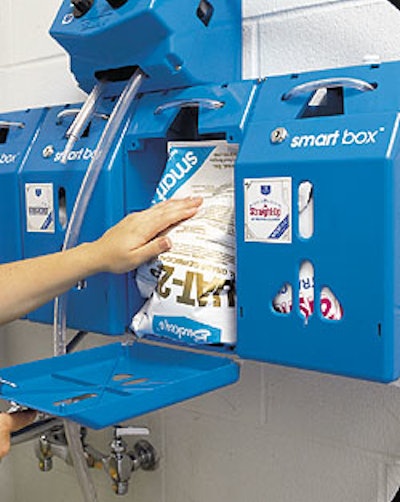At St. Louis-based Buckeye Intl., August ’99 saw the introduction of a 5-L (1.32-gal) stand-up pouch for concentrated cleaning chemicals. An alternative to a 5-gal bag-in-box format, the new package has brought a whole new level of convenience to janitorial personnel who use Buckeye products.
Called the Smart Sac, the stand-up pouch from Kapak (Minneapolis, MN) fits inside the equally new Smart Box. The Smart Box is typically mounted on the wall of a custodial closet or maintenance room. A janitor places the Smart Sac upside down in the Smart Box. After removing a polypropylene closure from the Smart Sac’s fitment, the janitor inserts a probe into the fitment. The other end of this probe is connected to a water source. The janitor uses a mixing dial on the front panel of the dispensing system to select the correct ratio of cleaning concentrate to water. Then, by pressing a dispensing button, the janitor can fill a bucket or other container with whatever amount of cleaning liquid is desired. Vacuum pressure pulls chemical concentrate from the sac along with the water.
To appreciate the advantages of the flexible pouch, it helps to look at how Buckeye customers use the alternative package, the 5-gal bag-in-box. This package is still popular with customers who go through huge quantities of Buckeye products. It, too, is connected to a water source for easy proportioning of water and concentrate. But it’s too heavy to mount neatly in a wall unit like the Smart Sac. And basically it’s just not as easy to handle, says Scott Criswell, vice president and director of marketing at Buckeye.
Handle provides convenience
“The Smart Sac is a much easier container to handle. It’s only 1.32 gallons and it’s got a nice handle,” he says. “It’s also a totally no-product-touch container. The only way you’re going to get product out is [through the probe].” The Smart Sac is also equipped with a convenient reclosable fitment in the top corner of the pouch, opposite the die-cut handle. The fitment was designed in conjunction with Menshen Packaging USA (Waldwick, NJ).
Predictably, buying Buckeye product in the Smart Sac is a more costly proposition than buying the 5-gal bag-in-box. Criswell estimates an upcharge of about 30% on a per-gallon basis. But that isn’t keeping customers away. According to Criswell, the Smart Sac has done “extremely well” in the marketplace since its launch.
“People don’t purchase it because it’s cheaper,” Criswell says. “They like it because of its benefits. It’s a value-added package.”
In developing the Smart Sac, Kapak designers performed extensive tests to determine whether the laminations could pass stringent two-meter drop tests. They also had to ensure that the pouch would fit into the Smart Box dispensing unit and that the custom high-density polyethylene fitment, which contains a silicon valve, would meet Buckeye’s “no-product-touch” criteria.
Eventually it was determined that two different laminations should be used to accommodate the 16-item product line. The first lamination includes a combination of nylon and ultra-low-density polyethylene. The second combines nylon and ethylene vinyl alcohol and is primarily used for more chemically aggressive products. The precise makeup of the 9-mil film is considered proprietary.
Production
Both structures also incorporate polyester, and this layer is reverse printed on an eight-color gravure press. The press’s drying system dries the ink solvent thoroughly, which helps bond the printed substrate to its adjacent substrate during laminating.
After laminating, the film is cured at 104? F for three days, which strengthens the bonds between layers. The pouches are then formed on a machine at Kapak. The Smart Sac is top filled and then heat sealed on a fill/seal unit at the Buckeye facility. The filled pouch is then case packed, three per corrugated shipper.
Buckeye worked in conjunction with equipment manufacturers for two years to develop the customized f/s unit and case packer that could fill and handle a large volume of pouched liquid. All the machinery is proprietary.
According to Criswell, the extra time and energy put into the pouch has certainly paid off. “The pouch has done extremely well,” he says. “We believe that’s where the future is.”

























